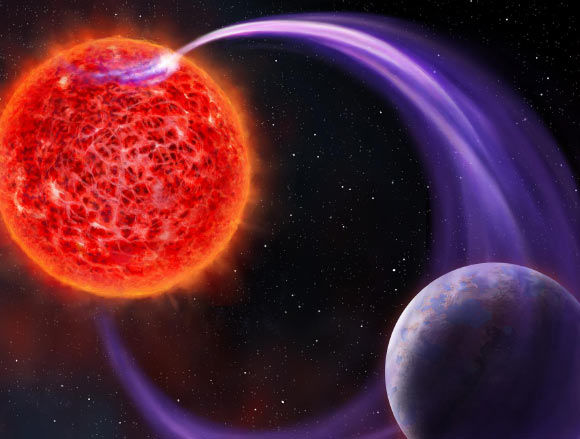Astronomers Find New Way to Study Planets around Red Dwarf Stars | Astronomy – Sci-News.com
Using the Low Frequency Array (LOFAR) radio telescope, astronomers have observed radio waves that carry the distinct signatures of extraterrestrial aurorae, caused by the interaction between the magnetic field of Gliese 1151, an M4.5-type dwarf star located approximately 26 light-years away, and a planet in orbit around it. Radio emission from a star-planet interaction has been long predicted, but this is the first time astronomers have been able to detect and decipher these signals.

This is an artistic impression of a red dwarf star’s magnetic interaction with its exoplanet. Image credit: Danielle Futselaar, Artsource.nl.
Red dwarfs are the most abundant type of star in our Milky Way Galaxy, but much smaller and cooler than our own Sun. This means for a planet to be habitable, it has to be significantly closer to its star than the Earth is to the Sun.
Red dwarfs also have much stronger magnetic fields than the Sun, which means that a habitable planet around a red dwarf is exposed to intense magnetic activity.
This can heat the planet and even erode its atmosphere. The radio emissions associated with this process are one of the only tools available to probe the interaction between such planets and their stars.
“The motion of the planet through a red dwarf’s strong magnetic field acts like an electric engine much in the same way a bicycle dynamo works,” said Dr. Harish Vedantham, an astronomer in the Netherlands Institute for Radio Astronomy (ASTRON).
“This generates a huge current that powers aurorae and radio emission on the star.”
Thanks to the Sun’s weak magnetic field and the larger distance to the planets, similar currents are not generated in our Solar System. However, the interaction of Jupiter’s moon Io with Jupiter’s magnetic field generates a similarly bright radio emission, even outshining the Sun at sufficiently low frequencies.
“We adapted the knowledge from decades of radio observations of Jupiter to the case of Gliese 1151,” said Dr. Joe Callingham, a postdoctoral researcher at the ASTRON.
“A scaled-up version of Jupiter-Io has long been predicted to exist in star-planet systems, and the emission we observed fits the theory very well.”
To be sure, the astronomers had to rule out an alternate possibility — that the interacting bodies are two stars in a close binary system instead of a star and its exoplanet.
They searched for the signature of a companion star using the HARPS-N instrument on the Italian Telescopio Nazionale Galileo on La Palma, Spain.
“Interacting binary stars can also emit radio waves,” said Dr. Benjamin Pope, an astronomer at New York University.
“Using optical observations to follow up, we searched for evidence of a stellar companion masquerading as an exoplanet in the radio data. We ruled this scenario out very strongly, so we think the most likely possibility is an Earth-sized planet too small to detect with our optical instruments.”
The authors are now concentrating on finding similar emission from other stars.
“We now know that nearly every red dwarf hosts terrestrial planets, so there must be other stars showing similar emission. We want to know how this impacts our search for another Earth around another star,” Dr. Callingham said.
“If we find that most red dwarf planets are blasted by intense stellar winds, this is bad news for their habitability,” Dr. Pope said.
The group expects this new method of detecting exoplanets will open up a new way of understanding the habitat of exoplanets.
“The long-term aim is to determine what impact the star’s magnetic activity has on an exoplanet’s habitability, and radio emissions are a big piece of that puzzle,” Dr. Vedantham said.
“Our work has shown that this is viable with the new generation of radio telescopes and put us on an exciting path.”
The research is reported in two papers in the journal Nature Astronomy and the Astrophysical Journal Letters.
_____
H.K. Vedantham et al. Coherent radio emission from a quiescent red dwarf indicative of star–planet interaction. Nat Astron, published online February 17, 2020; doi: 10.1038/s41550-020-1011-9
Benjamin J.S. Pope et al. 2020. No Massive Companion to the Coherent Radio-emitting M Dwarf GJ 1151. ApJL 890, L19; doi: 10.3847/2041-8213/ab5b99






